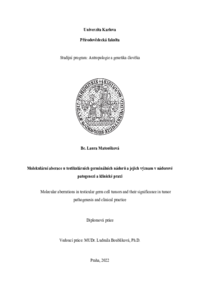Molekulární aberace u testikulárních germinálních nádorů a jejich význam v nádorové patogenezi a klinické praxi
Molecular aberrations in testicular germ cell tumors and their significance in tumor pathogenesis and clinical practice
diploma thesis (DEFENDED)

View/
Permanent link
http://hdl.handle.net/20.500.11956/176556Identifiers
Study Information System: 232367
Collections
- Kvalifikační práce [20869]
Author
Advisor
Referee
Vymetálková, Veronika
Faculty / Institute
Faculty of Science
Discipline
Anthropology and Human Genetics
Department
Department of Anthropology and Human Genetics
Date of defense
13. 9. 2022
Publisher
Univerzita Karlova, Přírodovědecká fakultaLanguage
Czech
Grade
Good
Testikulární germinální nádory (TGCT) jsou celkově vzácné, ale současně také nejčastěji se vyskytující zhoubné nádory u dospívajících a mladých mužů. Predispozice pro vznik TGCT zahrnují faktory genetické - několik desítek objevených rizikových lokusů v DNA, epigenetické změny DNA, alterace různých signálních drah, i zevní rizikové faktory environmentálního charakteru. Tyto nádory často velmi dobře reagují na léčbu cisplatinou, nicméně u části pacientů dochází k rezistenci na toto cytostatikum. Vznik cisplatinové rezistence, stejně tak jako molekulárně-biologické vlastnosti TGCT a jejich role v patogenezi, jsou doposud relativně málo probádané jevy. S tím souvisí i malý pokrok v léčbě TGCT a nedostupnost cílené biologické léčby, která by byla efektivní u pacientů s cisplatinovou rezistencí a/nebo celkově špatnou prognózou onemocnění. Vzhledem k tomu, že incidence TGCT v posledních desetiletích stoupá, jedná se o aktuální problém vyžadující urgentní řešení, jehož cílem je zlepšení přežití i kvality života pacientů s pokročilým TGCT. V teoretické části se práce věnuje hlavním v současnosti známým molekulárním charakteristikám TGCT a cisplatinové rezistence, mechanismům jejich vzniku, vlivu vnějších faktorů a mezipopulačním rozdílům ve výskytu TGCT. Cílem praktické části práce je identifikace a...
Testicular germ cell tumors (TGCT) are rare in general but they are also the most commonly occuring malignant tumors in adolescent and young males. Predispositions for the incidence of TGCT include genetic factors - a number of discovered DNA risk loci, epigenetic changes in DNA, alterations of various signaling pathways and also external environmental risk factors. These tumors usually respond to cisplatine therapy very well, nevertheless some patients develop a resistance to this cytostatic medicament. There is still relatively small amount of research dedicated to the cause of cisplatine resistance, as well as to bio-molecular characteristics of TGCT and their role in the pathogenesis. As a result, there is only a little development in TGCT therapy to this day and thus there is no targeted therapy available, which would be highly effective for treating patients with developed cisplatine resistance and/or poor prognosis of their disease. As a result of the fact that TGCT incidence is increasing in the recent decades, it can be considered an actual problem requiring urgent addressing in order to improve the survival rate and quality of life of patients with advanced TGCT. Theoretical part of this thesis deals with the main currently known molecular characteristics of TGCT as well as cisplatine...
